State-Sanctioned Violence against Black women
State-sanctioned violence against Black women refers to all forms of harm produced, promoted, and/or institutionalized by the state to the detriment of Black women, their families and communities. As the examples below illustrate, state-sanctioned violence against Black women is ingrained in the U.S. legal, educational, and health systems.
Law enforcement Heading link
Law enforcement has always played a significant role in subjecting Black women to violence (Noel & Perlow, 2014). For instance, during slavery, the US legal system did not recognized rape as a possible crime against Black women given that Black women were considered property and, as property, could have (or claim) no rights. In the Jim Crow era, the police used institutionalized rape as an instrument of terror and social control of Black communities as well as allowed white mobs to enter jails to sexually abuse and beat Black women (Noel & Parlor, 2014). In present society, Black women of all ages–and especially the poor, those with mental illness, transgender or gender non-conforming– continue to suffer at the hands of law enforcement. Black women are profiled, beaten, sexually abused, and murdered by police officers who, more often than not, are not held accountable for their crimes.
Black women face law enforcement violence for similar reasons Black men do (e.g., driving while Black, criminalization of poverty, and ‘the war on drugs’). Yet their stories the intersection of race, gender, class, and sexuality as well as presumptions of Black women as promiscuous, bad mothers, and super-humans produce particular experiences of police brutality for Black women. For example, when seeking the protection of the police from abusers at home or their communities, Black women are often left unprotected or, more disturbingly, killed by the police. They areparticularly vulnerable to sexual assault by police offers as well as subjected to excessive force even when pregnant or caring for their children.is multifaceted. verrepresented in the incarceration system, are physically and psychological abused as well as murdered by the police–often in the privacy of their homes, and even when they are seeking protection for themselves of their loved-ones (see fact sheet).
Infographic 1 Heading link
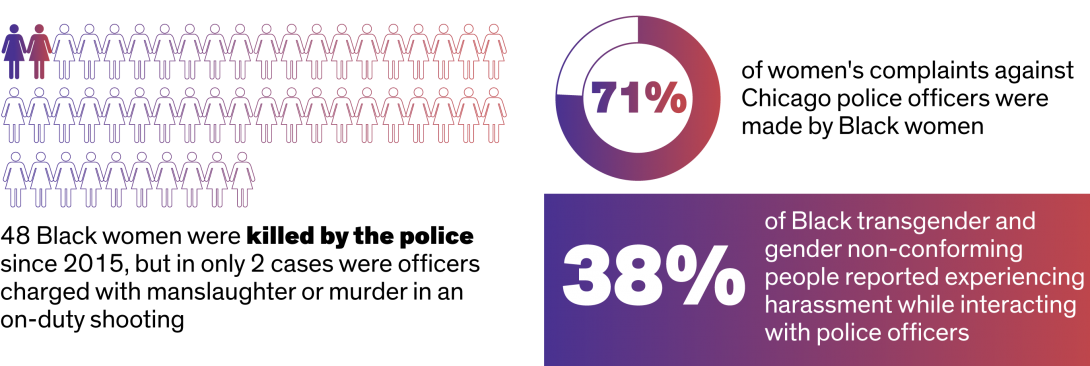
48 Black women were killed by the police since 2015, but in only 2 cases were officers charged with manslaughter or murder in an on-duty shooting; 71% of women’s complaints against Chicago police officers were made by Black women; 38% of Black transgender and gender non-conforming people reported experiencing harassment while interacting with police officers
Educational neglect Heading link
Educational neglect refers to the ways in which the state has promoted and/or being complicit in denying Black girls and women educational opportunities to grow and flourish. Education neglect includes, but is not limited to, harmful policies (e.g., closing of schools), the enforcement of the school-to-prison pipeline, and the inadequate preparation of an overwhelmingly white teaching workforce to teach Black and brown students. There are multiple ways that educational neglect promotes gender based violence against Black women (see facts sheet). For instance, Black women professional and economic opportunities are put in jeopardy by the lack of state investment in their school, perpetuating the cycle of Black women employment in low-wage occupations. The compliance of schools with police brutality has further enhanced the vulnerability of Black girls to physical and psychological harm as well as reinforce the school-to-prison pipeline. And, dress codes normalized eurocentric notions of respectability disproportionately penalizes Black girls.
Infographic 2 Heading link

Teachers and peers perceive Black girls’ hair as a sign of inferiority and defilement as early as preK-3rd grade; Black girls are six times more likely to be suspended from school than white girls; 5X Black girls are 53 times more likely to be expelled than white girls in New York; Teachers spend more time disciplining Black girls than attending to their academic growth
Health Neglect Heading link
Health neglect refers to the different ways in which the health of Black women are disregarded and put in jeopardy at the individual, collective, and structural levels. Multiple factors contribute to health outcomes including socioeconomic factors, social environments, lifestyle as well as access to preventative health-care (Frish, 2012; Office of Minority Health, 2005). Thus, the participation of the state in the disregard for Black women’s health is manifold, including: its failure to provide adequate, culturally competent medical care, being complicit in the continued exposure of Black women to toxic substances and food aphartaid in their communities as well as by not addressing structural systems (e.g.,capitalism, racism, patriarchy, poverty) that further expose Black women to illness (e.g., heart disease, diabetes, cancer, depression, anxiety) and other harms (e.g., chronic hunger & malnutrition, unsafe water).
The U.S. medical and scientific communities have relied heavily, and violently so, on the exploitation of Black women’s bodies for the development of knowledge and technologies. For instance, much groundbreaking developments in gynecology resulted from crude and violent experimentation in enslaved Black women (Owens, 2017). The eugenic control of Black women’s reproduction as well as the exploitation of Henrietta Lacks’ cells also serve as examples of the U.S. history of violence against Black women’s health. Along with exploitation, the historical neglect for Black women’s health continues to place Black women’s health in jeopardy and limit their opportunities to live fully (see fact sheet)
Inforgraphic 3 Heading link

Black girls and women are at greater risk of experiencing hunger and poverty for their entire lives; 2X Higher The rate of breast cancer mortality among Black women in their 30s when compared to white women; 1 in 5 poor Black women do not have health insurance; 57% of new cases of HIV were diagnosed in Black women
Learn more Heading link
Pushout: The criminalization of Black girls in school (2019) by Monique Morris & Jacoba Atlas
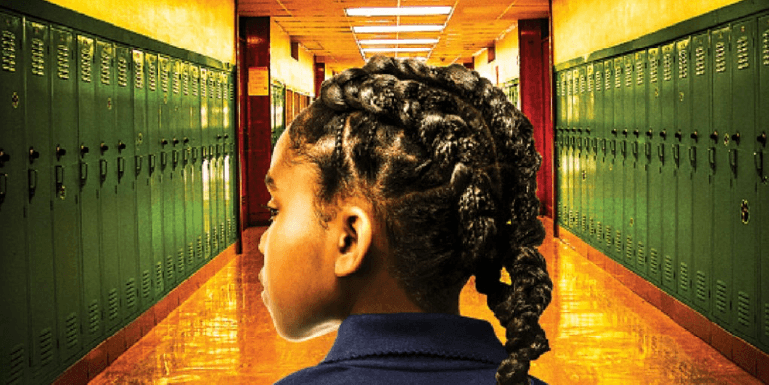
PUSHOUT is a documentary that takes a deeper look the practices, beliefs, and policies that impact Black girls in education. Drawing from the stories of Black girls of different ages as well as the research of experts in social justice, gender equality, and educational equity, the documentary shed light on the challenges Black face face in school as well as offer recommendations for individuals and policy makers in how to fulfill the needs of Black girls in positive ways.
Say Her Name: The life and death of Sandra Bland
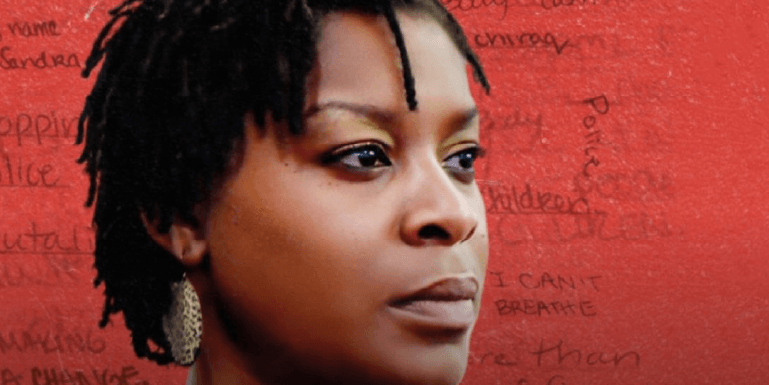
Say Her Name: Resisting police brutality against Black women by Kimberlé Williams Crenshaw and Andrea J. Ritchie with Rachel Anspach, Rachel Gilmer and Luke Harris
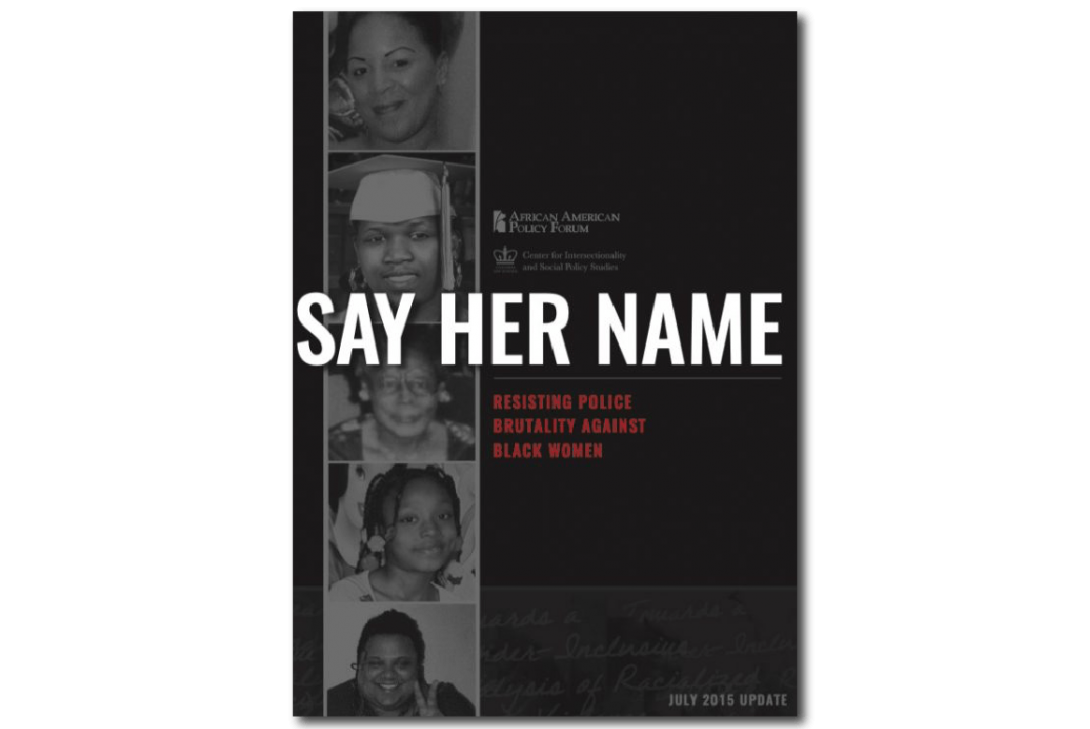
The Say Her Name: Resisting police brutality against Black women report uplifts the stories of Black women who have been killed by police and who have experienced gender-specific forms of police violence. It also provides analytical frames that–speaking to the specificities of race, gender, sexuality, and class–broadens dominant conceptions of who are victimized by state violence and what that violence looks like.
Black Girls Matter: Pushed out, overpoliced and underprotected by BY Kimberlé Williams Crenshaw with Priscilla Ocen and Jyoti Nanda
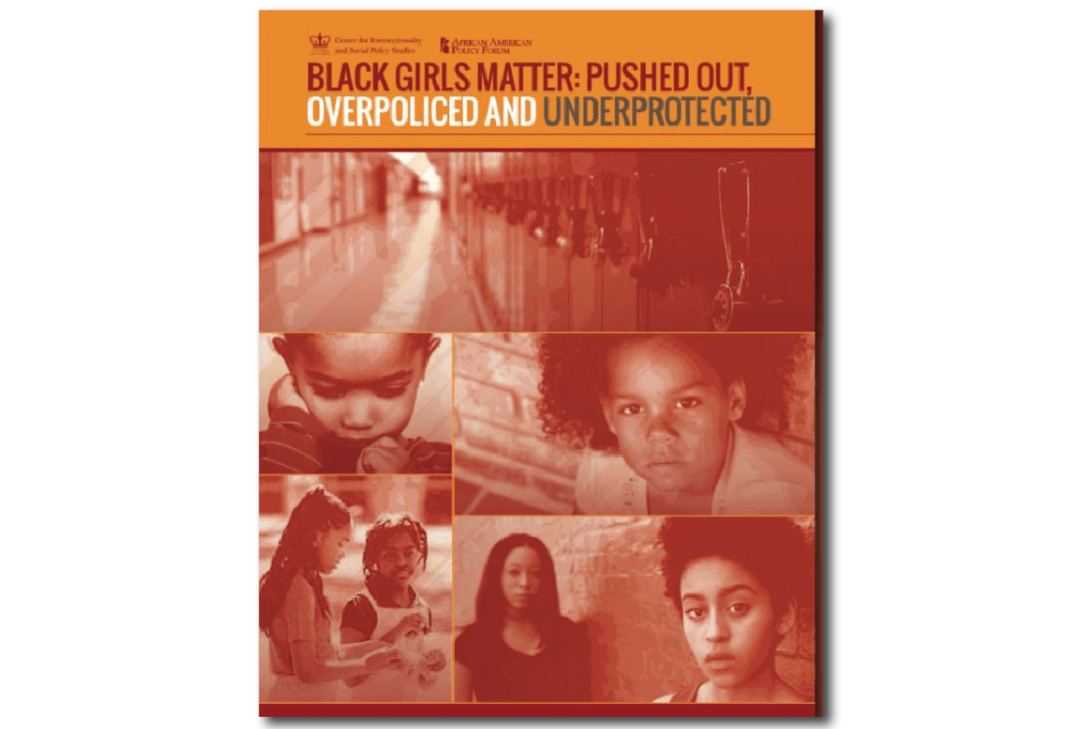
Black Girls Matter: Pushed out, overpoliced and underprotected provides a review of national data of disciplinary measures (e.g., suspense, expulsion) in school as well as personal interviews with girls New York and Boston. The report also provide recommendations to address and prevent racialized and gendered disparities in disciplinary practices.
